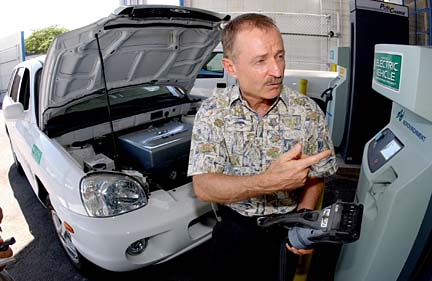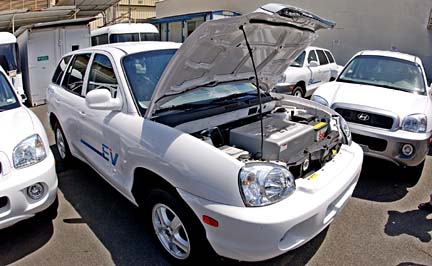
ASSOCIATED PRESS
Hawaii Electric Vehicle Demonstration Project Director Thomas L. Quinn shows the charging station for a Hyundai electric sport utility vehicle. One charge takes about $3 in electricity.
Electric SUV project
charges alongThe state and Hyundai extend
testing of the vehicles for two years
Cruising along the highway at 55 mph, it looks and runs like any of today's popular gas-guzzling sport utility vehicles.
But the 15 white Hyundai Santa Fe vehicles tested in Honolulu for the past two years are a glimpse of what's to come as the United States attempts to wean itself from its dependency on gasoline.
These prototype SUVs run almost silent and are powered entirely by electricity, producing no emissions.
"It's basically cheaper to operate and its virtually a maintenance-free vehicle -- there are no oil changes, no tune ups and the electric motor just goes and goes and goes and doesn't quit," said Thomas Quinn, director of the Hawaii Electric Vehicle Demonstration Project.
The state and Hyundai Motor Co. yesterday announced a two-year extension of the SUV program in Honolulu.
The 15 SUVs were tested by the city, Hawaiian Electric Co., the U.S. Air Force and the federally funded demonstration project. Twelve of the SUVs will be returned soon to South Korea for testing, but three will remain in Honolulu for further testing and development of rapid-charging capabilities.
ASSOCIATED PRESS
Test Hyundai SUVs are powered by engines that are run by 26 nickel-metal-hydride batteries.
Hyundai Executive Vice President Mon Sik Kwon said the success of the first two years of the program is encouraging and as a result, the company decided to continue evaluating electric vehicles.
Besides having no muffler, the SUVs look similar to any other Santa Fe on the road. But under the hood, there's a dramatic difference.
There is still a regular car battery and windshield fluid, but replacing the traditional gasoline engine is a large silver box that serves as the brains of the vehicle. Below the box is an electric motor powered by 26 nickel-metal-hydride batteries underneath the vehicle's frame. The system was designed by of California.
There are battery-powered cars already on the market in Honolulu, but finding one that doesn't look like a tricked-out golf cart that can actually go fast enough to get a speeding ticket may be difficult.
Although batteries may be phased out by fuel-cell vehicles that take oxygen and hydrogen, the technology of the Santa Fe's electric-drive system will likely remain the same.
"Electric motors are what's going to power vehicles in the future," Quinn said. "We're going to have lots of battery-powered electric vehicles and we're going to have lots of hybrid electric vehicles and some fuel cell electric vehicles and we're going to have a few internal combustion vehicles left."
Quinn said charging up an SUV costs about $3 worth of electricity and can last 80 to 90 miles.

